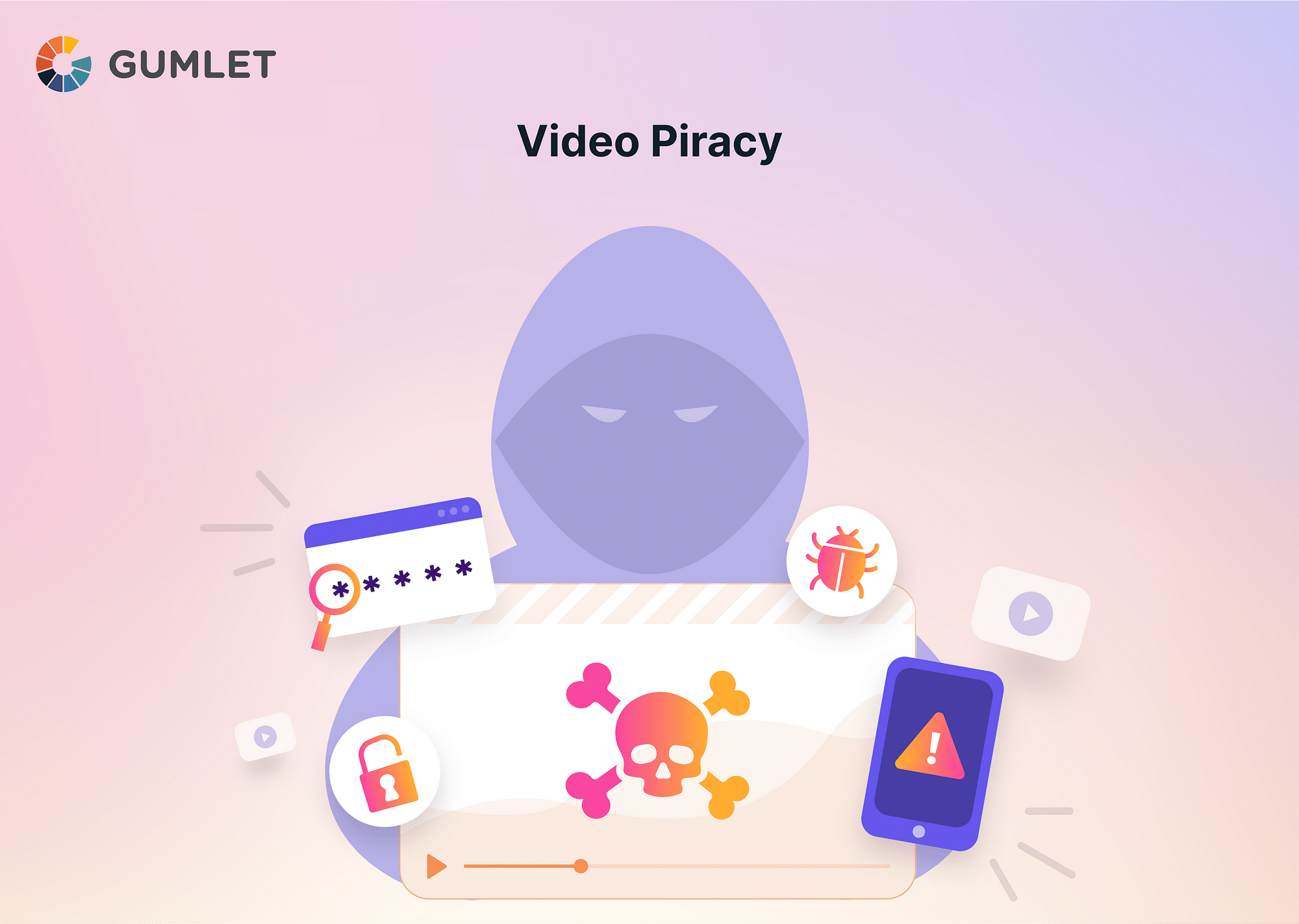What is Video Piracy?
Video piracy is the illicit replication, dissemination, or sale of copyrighted video content without proper authorization. This encompasses activities like streaming copyrighted videos online without permission, downloading copyrighted videos without proper licensing, or selling counterfeit video content.

Despite the increasing availability of legitimate streaming platforms, video piracy remains a significant issue. Statistics reveal that pirated video content accumulates more than 230 billion views annually. Globally, annual revenue losses due to digital piracy range from $40 billion to $97.1 billion within the movie sector alone.
Schedule a Demo with Our Video Expert!
Discover how Gumlet can help you build a cutting-edge video streaming infrastructure.
Consequences of Video Piracy
Here's a comprehensive breakdown of the consequences of video piracy:
- Financial Impact on Streaming Services: Research indicates that a staggering 80% of global online piracy occurs via illegal streaming. Beyond password sharing, selling compromised login credentials on black-market platforms compounds this challenge, resulting in substantial financial losses for streaming platforms.
- Threat to Content Creators: The repercussions of video piracy are predominantly felt by content creators, both local and international. Pirates employ various tactics, from software-assisted illegal downloads to screen recording and redistribution of content. This infringes on creators' intellectual property rights and places their financial interests at risk.
- Risk to Sensitive Business Content: This compromise of sensitive information can inflict lasting brand damage and undermine trust, making data protection a paramount concern for businesses. This includes confidential video meetings, internal virtual events, and other sensitive content.
- Challenges for Video Consumers: Pirated videos typically offer subpar quality compared to legitimate copies, impacting the overall viewing experience. Furthermore, devices that access pirated content can become infected with malware—leaving users vulnerable to identity theft and cybercrimes. Online video piracy can lead to dire consequences that far outweigh any perceived benefits.
Best ways to prevent online video piracy
Preventing online video piracy requires a multi-faceted approach. Here are two best practices to safeguard your video content:
Using a DRM
Digital Rights Management (DRM) encrypted video streaming technology is one of the most potent methods to counter video piracy. DRM involves encrypting videos using advanced streaming technologies to safeguard the rights of copyright holders and prevent unauthorized distribution and manipulation. DRM is a crucial shield in the digital landscape, particularly for peer-to-peer file exchanges, torrent downloads, and rampant online piracy.
By implementing DRM, companies can secure their intellectual property, keep customer data safe, ensure compliance, and thwart potential downtime.
There are widely used DRM systems like Google's Widevine and Apple's Fairplay that provide universal playback across diverse devices. Gumlet, for instance, supports both systems and ensures seamless content accessibility.
Using Watermarking
Watermarking is an effective technique to assert ownership and deter unauthorized use of videos. There are two types of watermarking: static and dynamic.
Dynamic watermarking, in particular, holds promise due to its adaptability. Unlike static watermarks that remain fixed, dynamic watermarks can move, change shape, and even appear/disappear during video playback. This flexibility enhances their resilience against potential pirates.
The good news is that adding dynamic watermarking to your videos is quite simple, especially with video delivery software like Gumlet. You can easily customize watermark attributes like size, transparency, location, and movement. Dynamic watermarks can even be personalized for each viewer—discouraging illegal sharing by incorporating personal information.
How can I detect if my videos are being pirated?
Detecting pirated videos requires proactive measures. Here are two effective methods to find out if your videos are being pirated:
Content Fingerprinting
Content fingerprinting offers a robust solution to identify instances where your videos might have been pirated or distributed without proper authorization. It includes generating a unique fingerprint for each of your video files—which is then compared against a database of known pirated videos. If a match is found, the content creator or copyright holder is alerted to potential unauthorized usage of their content.
Deep Packet Inspection
Deep Packet Inspection (DPI) is another powerful technique to combat video piracy. It involves scrutinizing the content within network traffic packets to detect patterns associated with pirated video traffic. This enables you to identify and prevent pirated video transmission—thereby upholding your content's integrity.
Conclusion
The repercussions of video piracy reverberate across industries. By incorporating DRM technology and dynamic watermarking, content creators can proactively safeguard their content against online piracy, maintaining ownership rights and protecting their intellectual property.
As for video consumers, it's important to support creators by opting for legal and ethical consumption methods—which will foster a sustainable ecosystem that upholds intellectual property rights and the efforts put into creating video content.
FAQs
What are the major reasons for video piracy?
Here are the key reasons for video piracy:
- Increasing prices on streaming platforms: Subscription costs on platforms like Netflix and Hulu to watch exclusive content are proliferating, prompting users to explore more budget-friendly alternatives, including piracy.
- The abundance of OTT options: The plethora of platforms like Peacock, Disney+, and Apple TV+ makes content readily accessible, simplifying piracy and quick distribution.
- Evolved piracy techniques: Modern piracy has shifted from low-quality theater recordings to high-quality versions available on pirate sites shortly after release, aided by easy access to various streaming sources.
What are the most used DRM systems across the web?
The most widely used DRM (Digital Rights Management) systems across the web are Apple's FairPlay and Google's Widevine.




